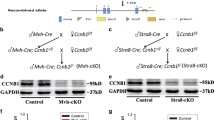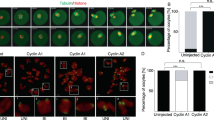Abstract
Mammalian spermatogenesis is a complicated developmental process by which undifferentiated germ cells continuously produce mature sperm throughout a lifetime. Stringent control of the cell cycle during spermatogenesis is required to ensure self-renewal of male germ line cells and differentiation of appropriate numbers of cells for the various lineages. Cyclins are key factors of cell cycle regulation and play crucial roles in governing both the mitotic and meiotic divisions that characterize spermatogenesis. Abnormal expression of some types of cyclins in the testes can induce apoptosis, infertility, testicular tumors, and other problems related to spermatogenesis in mammals. In this review, available data regarding cellular and molecular regulation of several different types of cyclins during mammalian spermatogenesis are collected and further discussed.

Similar content being viewed by others
Reference
Dym M (1994) Spermatogonial stem cells of the testis. Proc Natl Acad Sci USA 91:11287–11289
Ravnik SE, Wolgemuth DJ (1996) The developmentally restricted pattern of expression in the male germ line of a murine cyclin A, cyclin A2, suggests roles in both mitotic and meiotic cell cycles. Dev Biol 173:69–78
Sweeney C, Murphy M, Kubelka M et al (1996) A distinct cyclin A is expressed in germ cells in the mouse. Development 122:53–64
Yang R, Morosetti R, Koeffler HP (1997) Characterization of a second human cyclin A that is highly expressed in testis and in several leukemic cell lines. Cancer Res 57:913–920
Kramer A, Hochhaus A, Saussele S et al (1998) Cyclin A1 is predominantly expressed in hematological malignancies with myeloid differentiation. Leukemia 12:893–898
Yang R, Nakamaki T, Lubbert M et al (1999) Cyclin A1 expression in leukemia and normal hematopoietic cells. Blood 93:2067–2074
Liu D, Matzuk MM, Sung WK et al (1998) Cyclin A1 is required for meiosis in the male mouse. Nat Genet 20:377–380
Liu D, Liao C, Wolgemuth DJ (2000) A role for cyclin A1 in the activation of MPF and G2–M transition during meiosis of male germ cells in mice. Dev Biol 224:388–400
Salazar G, Liu D, Liao C et al (2003) Apoptosis in male germ cells in response to cyclin A1-deficiency and cell cycle arrest. Biochem Pharmacol 66:1571–1579
Nickerson HD, Joshi A, Wolgemuth DJ (2007) Cyclin A1-deficient mice lack histone H3 serine 10 phosphorylation and exhibit altered aurora B dynamics in late prophase of male meiosis. Dev Biol 306:725–735
Muller C, Readhead C, Diederichs S et al (2000) Methylation of the cyclin A1 promoter correlates with gene silencing in somatic cell lines, while tissue-specific expression of cyclin A1 is methylation independent. Mol Cell Biol 20:3316–3329
Lele KM, Wolgemuth DJ (2004) Distinct regions of the mouse cyclin A1 gene, Ccna1, confer male germ-cell specific expression and enhancer function. Biol Reprod 71:1340–1347
Salazar G, Joshi A, Liu D, et al (2005). Induction of apoptosis involving multiple pathways is a primary response to cyclin A1-deficiency in male meiosis. Dev Dyn 234:114–123
Baumer N, Sandstede ML, Diederichs S et al (2007) Analysis of the genetic interactions between Cyclin A1, Atm and p53 during spermatogenesis. Asian J Androl 9:739–750
Kawamata M, Nishimori K (2006) Mice deficient in Dmrt7 show infertility with spermatogenic arrest at pachytene stage. FEBS Lett 580:6442–6446
Diederichs S, Baumer N, Ji P et al (2004) Identification of interaction partners and substrates of the cyclin A1-CDK2 complex. J Biol Chem 279:33727–337241
Murphy M, Stinnakre MG, Senamaud-Beaufort C et al (1999) Delayed early embryonic lethality following disruption of the murine cyclin A2 gene. Nat Genet 15:83–86
Ravnik SE, Wolgemuth DJ (1999) Regulation of meiosis during mammalian spermatogenesis: the A-type cyclins and their associated cyclin-dependent kinases are differentially expressed in the germ-cell lineage. Dev Biol 207:408–418
Liao C, Li SQ, Wang X et al (2004) Elevated levels and distinct patterns of expression of A-type cyclins and their associated cyclin-dependent kinases in male germ cell tumors. Int J Cancer 108:654–664
Porlan E, Vidaurre OG, Rodríguez-Pena A (2007) Thyroid hormone receptor-beta (TRbeta1) impairs cell proliferation by the transcriptional inhibition of cyclins D1, E and A2. Oncogene. doi:10.1038/sj.onc.1210936
Horiuchi K, Umetani M, Minami T et al (2006) Wilms’ tumor 1-associating protein regulates G2/M transition through stabilization of cyclin A2 mRNA. Proc Natl Acad Sci USA 103:17278–17283
Brandeis M, Rosewell I, Carrington M et al (1998) Cyclin B2-null mice develop normally and are fertile whereas cyclin B1-null mice die in utero. Proc Natl Acad Sci USA 95:4344–4349
Zhu D, Dix DJ, Eddy EM (1997) HSP70–2 is required for CDC2 kinase activity in meiosis I of mouse spermatocytes. Development 124:3007–3014
Petri ET, Errico A, Escobedo L et al (2007) The crystal structure of human cyclin B. Cell Cycle 6:1342–1349
Kaushal N, Bansal MP (2007) Dietary selenium variation-induced oxidative stress modulates CDC2/cyclin B1 expression and apoptosis of germ cells in mice testis. J Nutr Biochem 18:553–564
Tschop K, Engeland K (2007) Cell cycle-dependent transcription of cyclin B2 is influenced by DNA methylation but is independent of methylation in the CDE and CHR elements. FEBS J 274:5235–5249
Blethrow JD, Glavy JS, Morgan DO et al (2008) Covalent capture of kinase-specific phosphopeptides reveals Cdk1-cyclin B substrates. Proc Natl Acad Sci USA 105:1442–1447
Nguyen TB, Manova K, Capodieci P et al (2002) Characterization and expression of mammalian cyclin B3, a prepachytene meiotic cyclin. J Biol Chem 277:41960–41969
Refik-Rogers J, Manova K, Koff A (2006) Misexpression of cyclin B3 leads to aberrant spermatogenesis. Cell Cycle 5:1966–1973
Sherr CJ, Roberts JM (1999) CDK inhibitors: positive and negative regulators of G1-phase progression. Genes Dev 13:1501–1512
Muller H, Lukas J, Schneider A et al (1994) Cyclin D1 expression is regulated by the retinoblastoma protein. Proc Natl Acad Sci USA 91:2945–2949
Spitkovsky D, Steiner P, Gopalkrishnan RV et al (1995) The role of p53 in coordinated regulation of cyclin D1 and p21 gene expression by the adenovirus E1A and E1B oncogenes. Oncogene 10:2421–2425
Chen X, Bargonetti J, Prives C (1995) p53, through p21 (WAF1/CIP1), induces cyclin D1 synthesis. Cancer Res 55:4257–4263
Beumer TL, Roepers-Gajadien HL, Gademan IS et al (2000) Involvement of the D-type cyclins in germ cell proliferation and differentiation in the mouse. Biol Reprod 63:1893–1898
Ravnik SE, Rhee K, Wolgemuth DJ (1995) Distinct patterns of expression of the D-type cyclins during testicular development in the mouse. Dev Genet 16:171–178
Yu F, Yang G, Zhao Z et al (2007) Apoptosis related protein 3, an ATRA-upregulated membrane protein arrests the cell cycle at G1/S phase by decreasing the expression of cyclin D1. Biochem Biophys Res Commun 358:1041–1046
Nakayama H, Nishiyama H, Higuchi T et al (1996) Change of cyclin D2 mRNA expression during murine testis development detected by fragmented cDNA subtraction method. Dev Growth Differ 38:141–151
Bartkova J, Rajpert-de Meyts E, Skakkebaek NE et al (1999) D-type cyclins in adult human testis and testicular cancer: relation to cell type, proliferation, differentiation, and malignancy. J Pathol 187:573–581
Fujino RS, Ishikawa Y, Tanaka K et al (2006) Capillary morphogenesis gene (CMG)-1 is among the genes differentially expressed in mouse male germ line stem cells and embryonic stem cells. Mol Reprod Dev 73:955–966
Tan KA, Turner KJ, Saunders PT et al (2005) Androgen regulation of stage-dependent cyclin D2 expression in sertoli cells suggests a role in modulating androgen action on spermatogenesis. Biol Reprod 72:1151–1160
Zhang Q, Wang X, Wolgemuth DJ (1998) Developmentally regulated expression of cyclin D3 and its potential in vivo interacting proteins during murine gametogenesis. Endocrinology 140:2790–2800
Feng LX, Ravindranath N, Dym M (2000) Stem cell factor/c-kit up-regulates cyclin D3 and promotes cell cycle progression via the phosphoinositide 3-kinase/p70 S6 kinase pathway in spermatogonia. J Biol Chem 275:25572–25576
Geng Y, Yu Q, Whoriskey W et al (2001) Expression of cyclins E1 and E2 during mouse development and in neoplasia. Proc Natl Acad Sci USA 98:13138–13143
Geng Y, Yu Q, Sicinska E et al (2003) Cyclin E ablation in the mouse. Cell 114:431–443
Wu J, Jester WF Jr, Laslett AL et al (2003) Expression of a novel factor, short-type PB- cadherin, in Sertoli cells and spermatogenic stem cells of the neonatal rat testis. J Endocrinol 176:381–391
Wu J, Jester WF Jr, Orth JM (2001) T3-regulated expression of a novel attachment factor, PB-cadherin, may be critical for development of neonatal testicular stem cells. Mol Biol Cell 12:118a (supplement)
Wu J, Jester WF Jr, Orth JM (2005) Short-type PB-cadherin promotes survival of gonocytes and activates JAK-STAT signaling. Dev Biol 284:437–450
Wu J, Zhang Y, Tian GG et al (2008) Short-type PB-cadherin promotes self-renewal of spermatogonial stem cells via multiple signaling pathways. Cell Signal 20:1052–1060
Acknowledgments
This work was supported by a key Program of the National Natural Scientific Foundation of China (No. 30630012, to J.W.), and Sponsored by the Shanghai Pujing Program (No. 06PJ14058, to J.W.) and Shanghai Leading Academic Discipline Project (No. B205).
Author information
Authors and Affiliations
Corresponding author
Rights and permissions
About this article
Cite this article
Yu, Q., Wu, J. Involvement of cyclins in mammalian spermatogenesis. Mol Cell Biochem 315, 17–24 (2008). https://doi.org/10.1007/s11010-008-9783-8
Received:
Accepted:
Published:
Issue Date:
DOI: https://doi.org/10.1007/s11010-008-9783-8




